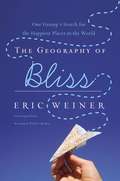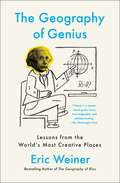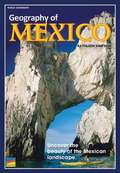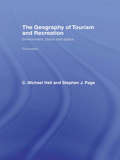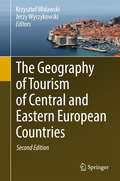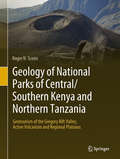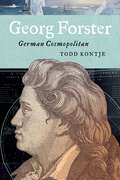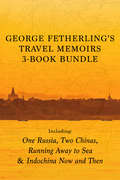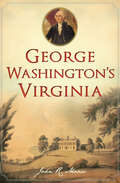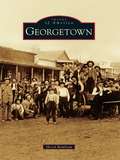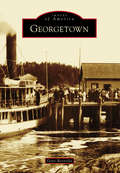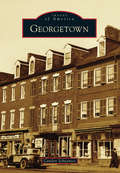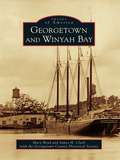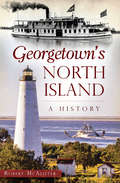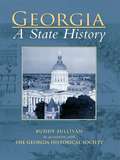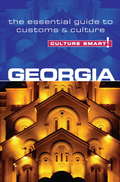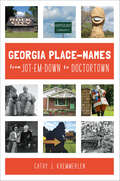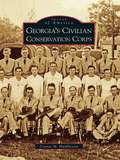- Table View
- List View
The Geography of Bliss: One Grump's Search for the Happiest Places in the World
by Eric WeinerWeiner investigates why some places are happy, notably the Netherlands, Switzerland, Bhutan, Qatar, Iceland, Moldova, Thailand, Great Britain, India, and America.
The Geography of Bliss: One Grump's Search for the Happiest Places in the World
by Eric WeinerNow a new series on Peacock with Rainn Wilson, THE GEOGRAPHY OF BLISS is part travel memoir, part humor, and part twisted self-help guide that takes the viewer across the globe to investigate not what happiness is, but WHERE it is. Are people in Switzerland happier because it is the most democratic country in the world? Do citizens of Qatar, awash in petrodollars, find joy in all that cash? Is the King of Bhutan a visionary for his initiative to calculate Gross National Happiness? Why is Asheville, North Carolina so damn happy? In a unique mix of travel, psychology, science and humor, Eric Weiner answers those questions and many others, offering travelers of all moods some interesting new ideas for sunnier destinations and dispositions.
The Geography of Genius: A Search for the World's Most Creative Places from Ancient Athens to Silicon Valley
by Eric Weiner"An intellectual odyssey, a traveler's diary, and a comic novel all rolled into one. Smart, original, and utterly delightful." --Daniel Gilbert, Harvard professor and bestselling author of Stumbling on Happiness "A charming mix of history and wisdom cloaked as a rollicking travelogue." --Walter Isaacson, bestselling author of Steve Jobs Travel the world with Eric Weiner, the New York Times bestselling author of The Geography of Bliss, as he journeys from Athens to Silicon Valley--and throughout history, too--to show how creative genius flourishes in specific places at specific times.In The Geography of Genius, acclaimed travel writer Weiner sets out to examine the connection between our surroundings and our most innovative ideas. He explores the history of places, like Vienna of 1900, Renaissance Florence, ancient Athens, Song Dynasty Hangzhou, and Silicon Valley, to show how certain urban settings are conducive to ingenuity. And, with his trademark insightful humor, he walks the same paths as the geniuses who flourished in these settings to see if the spirit of what inspired figures like Socrates, Michelangelo, and Leonardo remains. In these places, Weiner asks, "What was in the air, and can we bottle it?" This link can be traced back through history: Darwin's theory of evolution gelled while he was riding in a carriage. Freud did his best thinking at this favorite coffee house. Beethoven, like many geniuses, preferred long walks in the woods. Sharp and provocative, The Geography of Genius redefines the argument about how genius came to be. His reevaluation of the importance of culture in nurturing creativity is an informed romp through history that will surely jumpstart a national conversation.
The Geography of Madness: Penis Thieves, Voodoo Death, and the Search for the Meaning of the World's Strangest Syndromes
by Frank BuresJon Ronson meets David Grann in this fascinating, wildly entertaining adventure and travel story about how culture can make us go totally insaneThe Geography of Madness is an investigation of "culture-bound" syndromes, which are far stranger than they sound. Why is it, for example, that some men believe, against all reason, that vandals stole their penises, even though they're in good physical shape? In The Geography of Madness, acclaimed magazine writer Frank Bures travels around the world to trace culture-bound syndromes to their sources--and in the process, tells a remarkable story about the strange things all of us believe.From the Hardcover edition.
Geography of Mexico
by Kathleen Simpson Vicki RushworthFind out about warm beaches, high deserts, dense jungles, and active volcanoes as you journey through the six geographical regions of Mexico.
Geography of Texas
by Erik ProutPart One is organized into two distinct chapters: Texas and geography. Chapter One is an initial survey of and discussion about Texas. Chapter Two is a condensed introduction to geography, so the reader can better understand the author. The second chapter includes the purpose of regional geography, some foundational geographical ideas, and a primer on maps, which is an important tool for geographers and an essential skill in geography.
The Geography of Tourism and Recreation: Environment, Place and Space
by C. Michael Hall Stephen J. PageHighlighting the inter-relationships between tourism, leisure and recreation, this revised edition introduces growing theoretical debates (from geography and the wider social science arena) to assess how new conceptualizations of tourism and leisure are advancing knowledge and understanding. Underpinning this book is the concept of the evolving nature of geography and social science, and their role in leading the analysis of the leisure phenomenon as a living subject, which has recently seen significant contributions from the new cultural geographies of consumption and leisure. These developments are clearly introduced, giving readers new to the subject area bite-sized introductions to key issues. Whilst this third edition retains the successful format and structure of previous editions, making it attractive and user-friendly to students without being overwhelming, it is completely revised and redeveloped to accommodate new case studies, insights, summary points and learning objectives. It is the only book to systematically compare and contrast in a spatial context, tourism and recreation in relation to leisure time, and its encyclopaedic reference section provides an excellent resource for new students. Retaining a global focus, this edition now features a greater emphasis on North America, and investigates the importance of less developed countries and the critical issues surrounding inequality, exploitation, underdevelopment and globalization as powerful forces affecting tourism and leisure.
The Geography of Tourism and Recreation: Environment, Place and Space
by C. Michael Hall Stephen J. PageThis fourth edition of The Geography of Tourism and Recreation provides students with a comprehensive introduction to the interrelationship between tourism, leisure and recreation from geographical and social science perspectives. It still remains the only book to systematically compare and contrast in a spatial context, tourism and recreation in relation to leisure time, offering insight into the demand, supply, planning, destination management and impacts of tourism and recreation.Whilst retaining its accessible style and approach this edition has been significantly updated to reflect recent developments and new concepts from geography which are beginning to permeate the tourism and recreational field. New features include: Content on the most recent developments, climate change, sustainability, mobilities and crisis management in time and space as well as trends such as low cost airlines and the control of land transport by transnational operators in the EU such as Arriva. More attention to management issues such as innovation and the spatial consequences for tourism and leisure development. New case studies and examples to showcase real life issues, from both developed and developing countries, especially the US, China and South Africa. Completely revised and redeveloped to accommodate new, user- friendly features: case studies, insights, summary points and learning objectives. Written by leading academics, this is essential reading for all tourism, geography, leisure and recreation students.
Geography of Tourism First Semester FYBA New NEP Syllabus - SPPU
by Dr Jyotiram C. More Prof. Harishchandra S. Timbole Prof. Dr. Sanjay D. PagarThe textbook "Geography of Tourism" for first-year B.A. students, following the NEP 2024 syllabus, explores tourism as an interdisciplinary subject within human geography. It covers foundational concepts like the nature, scope, and importance of tourism geography, as well as the determinants of tourism development—physical, socio-cultural, and political. The book also delves into classifications of tourism, including emerging forms such as agro-tourism and eco-tourism. With a focus on sustainable development, it examines the economic, social, and environmental impacts of tourism and the strategies required for effective management and planning, making it a vital resource for students and educators.
The Geography of Tourism of Central and Eastern European Countries
by Jerzy Wyrzykowski Krzysztof WidawskiThis book presents a comprehensive overview of the tourism market development in Central and Eastern European countries. It is divided into 13 chapters, including a chapter dedicated to Belarus, all richly illustrated with colorful maps and illustrations. The book presents the output of international conferences organized every two years by the Department of Regional Geography and Tourism of the University of Wroclaw which have served as inspiration for this book. Chapter 1 provides the characteristics of 20 post-communist countries of the region on the international tourism market and it sets the background and context for the following chapters. Chapters 2 to 13 present the condition of research on tourism, tourist attractions, tourist infrastructure, tourism movement, main types of tourism as well as tourist regionalization in 12 Central and Eastern European countries. All chapters have been updated with reference to the statistics. This book is a revised and updated version of "The Geography of Tourism of Central and Eastern Europe Countries" published by the Department of Regional Geography and Tourism of Wroclaw University in 2012. It has been developed by a group of specialists through their exchange of research experience in the scope of international tourism in Central and Eastern Europe.
Geologic Trips: San Francisco and the Bay Area
by Ted KonigsmarkThis book is written for the non-geologist and describes seven geologic trips that will give the reader an understanding of the rocks, faults, earthquakes, and landforms of San Francisco and the Bay Area.
Geology of National Parks of Central/Southern Kenya and Northern Tanzania: Geotourism Of The Gregory Rift Valley, Active Volcanism And Regional Plateaus
by Roger N. ScoonThis book describes the interrelationship between the spectacular geology of an area of East Africa that includes a branch of the rift valley, as well as giant freestanding ice-capped mountains and extraordinarily toxic, alkaline lakes, and some of the greatest concentrations of wildlife on Earth. It suggests that geological processes that have shaped the iconic landforms, including active volcanoes, may also be responsible for the unusually diverse speciation which characterises the region. Moreover, it is not a coincidence that important palaeoanthropological discoveries have been unearthed in the region. National parks and conservation areas have tremendous potential for geotourism and the book assists both tour guides and visitors in this regard. In addition, the book may provide a better understanding to management of the importance of geology for sustaining wildlife.
Geology of National Parks (Sixth Edition)
by Ann G. Harris Esther Tuttle Sherwood D. TuttleHighlights the local history as well as the geologic features and developments of national parks formed by stream erosion and weathering, glaciers and wave action, igneous activity, mountain building and uplift, and ground water.
Georg Forster: German Cosmopolitan (Max Kade Research Institute)
by Todd KontjeGeorg Forster (1754–1794) was famous during his lifetime, notorious after his death, and largely forgotten by the later nineteenth century. Remembered today as the young man who sailed around the world with Captain Cook and as one of the leading figures in the revolutionary Republic of Mainz, Forster was also a prolific writer and translator who left behind two travelogues, a series of essays on diverse topics, and numerous letters. This in-depth look at Forster’s work and life reveals his importance for other writers of the age. Todd Kontje traces the major intellectual themes and challenges found in Forster’s writings, interweaving close textual analysis with his rich but short life. Each chapter engages with themes that reflect the current debates in eighteenth-century literary and cultural studies, including changing notions of authorship, multilingualism, the representation of so-called primitive societies, Enlightenment ideas about race, and early forms of ecological thinking. As Kontje shows, Forster’s peripatetic life, malleable sense of national identity, and fluency in multiple languages contrast with the image of the solitary genius in the “age of Goethe.” In this way, Forster provides a different model of authorship and citizenship better understood in the context of an increasingly globalized world.Compellingly argued and engagingly written, this book restores Forster to his rightful place within the German literary tradition, and in so doing, it urges us to reconsider the age of Goethe as multilingual and malleable, local and cosmopolitan, dynamic and decentered. It will be welcomed by specialists in German studies and the Enlightenment.
George Fetherling's Travel Memoirs 3-Book Bundle: One Russia, Two Chinas / Running Away to Sea / Indochina Now and Then
by George FetherlingThe travel writing of celebrated writer George Fetherling is filled with vivid prose and bizarre characters. Includes: One Russia, Two Chinas A travel narrative written over the course of ten years, One Russia, Two Chinas is about change and resistance to change in the postmodern world. A valuable document that freezes some important world events for close inspection. Running Away to Sea: Round the World on a Tramp Freighter At a turning point in his life, George Fetherling embarked on an adventure to sail round the world on one of the last of the tramp freighters. The four-month voyage carried him 30,000 nautical miles from Europe via the Panama Canal to the South Pacific and back by way of Singapore, Indonesia, the Indian Ocean, and Suez. Written with dash, colour, and droll humour, Fetherling’s narrative is peopled by a rich cast of characters, from the Foreign Legionnaires of French Polynesia to the raskol gangs of Papua New Guinea. Indochina Now and Then George Fetherling recounts multiple journeys through Vietnam, Laos, and Cambodia, keeping an eye peeled and an ear cocked for whatever faint traces of French rule might remain. Indochina Now and Then is a travel narrative that leaves an indelible impression in the readers imagination.
George Washington's Virginia (History And Guide Ser.)
by John R. MaassGeorge Washington slept, worked, and fought here . . . A historian&’s guide to Virginia sites and landmarks associated with the Founding Father. Born in the Tidewater region, George Washington was reared near Fredericksburg and took up residence at Mount Vernon along the Potomac River. As a young surveyor, he worked in Virginia&’s backcountry. He began his military career as a Virginia militia officer on the colony&’s frontier. The majority of his widespread landholdings were there—and his entrepreneurial endeavors ranged from the swamplands of the Southeast to the upper Potomac River Valley. In this book, historian John R. Maass explores the numerous sites all over the Commonwealth associated with Washington—and demonstrates their lasting importance. Includes photos and illustrations
Georgetown
by Sheryl RambeauAt the beginning of the 20th century, historian Herman Daniel Jerrett noted that there was "no other part of the world with a placer seam formation filled with small gold-bearing veins and veinlets, so great or so crumpled, crushed and its fold mashed together, as that on the Georgetown Divide." First a simple base and supply camp for early miners, Georgetown survived despite repeated challenges from fires and economic slumps. Now rebuilt, it offers physical proof of the hardy pioneer spirit that settled this small town in the Sierra Nevada foothills. Historic Main Street offers numerous examples of "fireproof" architectural styles, more hopeful than realistic, including the 100-foot-wide Main Street itself, unique in Mother Lode mining towns.
Georgetown
by Gene ReynoldsGeorgetown is an island located between the historic Kennebec and Sheepscot Rivers. Incorporated in l716, it was accessible from the mainland only by various ferries and local fishing boats until a bridge was erected in 1898. Maritime endeavors like fishing and shipbuilding emerged as the major industries in town very early on and continue to be a primary means of employment today. Georgetown encompasses several beautiful villages, all of which retain a feeling of an older time and place. As the area continued to grow as a destination for artists in the early 1900s, several notable photographers congregated at the Seguinland Hotel, now known as Grey Havens Inn, to discuss starting a school that would ignite the development of commercial photography. One of the most recognizable parts of Georgetown is Reid State Park, which attracts visitors with its beautiful beaches. Today, residents take pride in the new historical society building, firehouse, post office, and restored community center.
Georgetown: Scoundrels, Sinners And Spies (Images of America)
by Canden SchwantesGeorgetown, a thriving neighborhood in the nation's capital, was established in 1751 as an independent city. As the land to its east was being developed into Washington, DC, the once sleepy river town grew and evolved. George Washington's adopted descendants lived down the street from where Kennedy lived before Camelot; Julia Child walked past the home of Robert Todd Lincoln; and a successful community of free black Americans was built around the corner from what had previously been a slave market. Georgetown depicts the history of a community whose roots span far beyond the prestigious university and upper-class neighborhood for which it is known. The images capture mansions and slums, thriving businesses and crumbling facades, an industrial revolution, and the closing of the C&O Canal.
Georgetown and Winyah Bay
by Mary Boyd Georgetown County Historical Society James H. ClarkGeorgetown lies just inland of the Atlantic Ocean at the upper reaches of Winyah Bay. For eons, five rivers have flowed through the countryside, offering lifeblood to a town and its people. Founded in 1729, Georgetown has seen the heights of prosperity in the indigo and rice crops and the depths of despair in the aftermath of the Civil War. Many famous names have connections here, such as Francis Marion, better known as the Swamp Fox; the Marquis de Lafayette; Thomas Lynch, a signer of the Declaration of Independence; and Vice Pres. Aaron Burr, just to name a few. Presidents and other dignitaries have visited with us over these 200-plus years and millions have luxuriated in the waters of our nearby beaches for generations.
Georgetown's North Island: A History
by Robert McalisterNorth Island has always been the beacon from the sea leading toward Georgetown, South Carolina. It was an island of exploration for the Spanish in 1526 and the first landing place of Lafayette, France's hero of the American Revolution, in 1777. It was a summer resort for aristocratic rice planters and their slaves from Georgetown and Waccamaw Neck until 1861. North Island's lighthouse, built in 1812, led thousands of sailing ships from all over the world past massive stone jetties and through Winyah Bay to Georgetown. Today, North Island is a sanctuary and laboratory for the study of nature's effects on this unique barrier island. Join historian Robert McAlister as he recounts the island's storied past.
Georgia: A State History (The\making Of America Ser.)
by Buddy Sullivan Georgia Historical SocietyGeorgia's past has diverged from the nation's and given the state and its people a distinctive culture and character. Some of the best, and the worst, aspects of American and Southern history can be found in the story of what is arguably the most important state in the South. Yet just as clearly Georgia has not always followed the road traveled by the rest of the nation and the region. Explaining the common and divergent paths that make us who we are is one reason the Georgia Historical Society has collaborated with Buddy Sullivan and Arcadia Publishing to produce Georgia: A State History, the first full-length history of the state produced in nearly a generation. Sullivan's lively account draws upon the vast archival and photographic collections of the Georgia Historical Society to trace the development of Georgia's politics, economy, and society and relates the stories of the people, both great and small, who shaped our destiny. This book opens a window on our rich and sometimes tragic past and reveals to all of us the fascinating complexity of what it means to be a Georgian.
Georgia - Culture Smart!
by Natia AbramiaGeorgia lies between Eastern Europe, Central Asia, and the Middle East, on the southeastern shore of the Black Sea. This small Caucasian country is used to playing a significant role in global geopolitics, and its strategic location at the crossroads of different civilizations has been a curse as well as a blessing. Once a battlefield of the Christian and Muslim worlds, today it is caught between its NATO aspirations and its location in Russia's backyard. The Silk Road brought the best of the world to Georgia. Its ancient Christian culture shows the influence of Arab, Persian, and Ottoman conquerors. Combined with this is a southern, "Mediterranean" feel, traces of the Soviet legacy, and a strong Western influence. What awaits the visitor is a unique culture that goes back thousands of years. Georgia has a rich historical heritage, wonderful food and wines, unforgettable scenery, authentic folk music and dances, an attractive business climate, and an educated and hospitable people for whom indulging a guest is more a religion than a duty. Culture Smart! Georgia offers invaluable insights and practical tips for tourists and business people alike. The author, Natia Abramia, guides you through the past and present-day realities of her motherland, explaining what makes people tick, how they live and feel, and how to get on with them. You will discover that the Georgians will not let you down. Learn how to reach their hearts, and they will charm you back.
Georgia Place-Names From Jot-em-Down to Doctortown
by Cathy J. KaemmerlenEver wonder how Rough and Ready got its name? Or what Stonesthrow is a stone's throw from? And surely the story behind Climax can't be…that thrilling, can it? The curious Georgian can't help pondering the seemingly endless supply of head-scratching place names that dot this state. Luckily, the intrepid Cathy Kaemmerlen stands ready to unravel the enigmas--Enigma is, in fact, a Georgia town--behind the state's most astonishing appellations. Cow Hell, Gum Pond, Boxankle and Lord a Mercy Cove? One town owes its name to a random sign that fell off a railcar, while another memorializes a broken bone suffered by a cockfight spectator. And just how many place names were inspired by insolent mules? Come on in to find out.
Georgia's Civilian Conservation Corps
by Connie M. HuddlestonAt a time when our country struggled with a deep financial depression, the United States began to see incredible numbers of men and women who could not find work. During the first days of his administration, Pres. Franklin D. Roosevelt sought to create opportunities for this country's uneducated and undereducated young men to find work, help support their families, and receive training in a variety of fields. President Roosevelt's own vision brought about the Civilian Conservation Corps (CCC). Images of America: Georgia's Civilian Conservation Corps examines the role these young men played in developing three national forests, three national monuments, a national battlefield, 10 state parks, and four military installations. This book illustrates and gives voice to the CCC's rich contribution to Georgia's landscape and history and allows us to understand how the creation of this social employment program was once seen as the shining example of FDR's New Deal.
